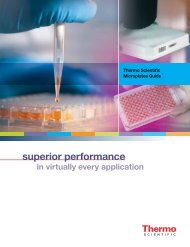PeloBiotech
Create successful ePaper yourself
Turn your PDF publications into a flip-book with our unique Google optimized e-Paper software.
www.pelobiotech.com<br />
lymphangiogenesis in a lymphatic organotypic co-culture model, providing valuable insights into the mechanisms<br />
underlying lymphatic vessel formation in the context of tumor microenvironment. Endothelial cells from the lymphatic<br />
system have been extensively studied for their role in lymphangiogenesis and the development of the lymphatic<br />
vasculature.<br />
Studies have demonstrated that Prox1 is a master control gene in the program specifying lymphatic endothelial cell fate,<br />
highlighting its essential role in the induction of the lymphatic endothelial cell phenotype. The expression of podoplanin<br />
in stromal fibroblasts has been associated with high lymphatic vessel density in triple-negative, basal marker-expressing,<br />
and high-grade breast carcinomas, indicating its potential as a marker for lymphatic endothelial cells and<br />
lymphangiogenesis. The differential response of lymphatic endothelial cells to angiopoietin-1 and angiopoietin-2 has<br />
been investigated, providing insights into the molecular regulation of lymphangiogenesis and the distinct functions of<br />
angiopoietins in lymphatic vessel development.<br />
Skeletal system<br />
We offer a variety of synovial cells, chondrocytes, osteoblasts, endothelial cells from various vessels, and tenocytes<br />
sourced from different animal species, with cell RNA from adults and fetuses all of which are extracted from various<br />
bones. Synovial cells have been studied for their modulatory effect on cell phenotype and metabolic behavior in<br />
osteoarthritic patients, providing insights into the inflammatory and metabolomic profile of synovial fluid and its impact<br />
on synovial cell behavior. Additionally, the inflammatory response of synovial fibroblasts has been investigated, shedding<br />
light on the regulation of synovial cell growth by polypeptide growth factors. Chondrocytes have been extensively utilized<br />
in the study of cartilage regeneration and the development of high-quality cartilage. Studies have focused on the potential<br />
of aged human articular chondrocytes for cartilage regeneration, aiming to reverse chondrocyte aging and enhance<br />
cartilage regeneration. Furthermore, the role of microRNA-224 in suppressing osteoblast differentiation by inhibiting<br />
SMAD4 has been investigated, providing insights into the molecular mechanisms underlying osteoblast differentiation<br />
and function.<br />
Osteoblasts have been studied for their role in bone formation and bone-related diseases, with a focus on the regulation<br />
of osteoblast proliferation and differentiation. The knockout of the BK channel in osteoblasts has been investigated to<br />
determine its impact on osteoblast function and bone formation. The proliferative actions of parathyroid hormonerelated<br />
protein (PTHrP) in chondrocytes have been studied, highlighting the role of the cyclin-dependent kinase inhibitor<br />
p57Kip2 in mediating PTHrP-induced proliferation in chondrocytes.<br />
Circulatory system<br />
We provide a diverse array of cells from different animal species, isolated from various arteries and veins. Our offerings<br />
include endothelial cells, MSCs, fibroblasts, peripheral blood cells with a variety of markers, NK cells, monocytes, and<br />
blood cells. Additionally, we offer MSCs with GFP and RFP tags, as well as smooth muscle cells, with available cell RNA.<br />
Mesenchymal stem cells (MSCs) have been extensively studied and utilized in various research and clinical applications<br />
due to their regenerative and immunomodulatory properties. MSCs have been identified and isolated from different<br />
sources, including the umbilical cord, bone marrow, adipose tissue, and other tissues. These cells have shown potential<br />
for use in tissue engineering, regenerative medicine, and immunotherapy. The expression of specific surface markers and<br />
the characterization of MSCs from various sources have been the focus of numerous studies, aiming to understand their<br />
properties and potential applications.<br />
Peripheral blood cells with a variety of markers have been extensively studied for their role in the immune response and<br />
as a source of hematopoietic stem cells. These cells have been used in the study of immune cell populations, including T<br />
cells, B cells, and natural killer (NK) cells. The expression of specific markers on peripheral blood cells has been investigated<br />
to understand their functions and to develop targeted therapies for various diseases. NK cells, a type of cytotoxic<br />
lymphocyte, have been studied for their role in the immune response against infected or malignant cells. These cells have<br />
been investigated for their potential use in cancer immunotherapy and as a treatment for viral infections. The expression<br />
of specific markers on NK cells has been studied to understand their activation and cytotoxic functions.<br />
Monocytes, which are a type of white blood cell, have been extensively studied for their role in the immune response<br />
and as precursors to macrophages and dendritic cells. These cells have been investigated for their potential use in<br />
immunotherapy and as a source of antigen-presenting cells. The expression of specific markers on monocytes has been<br />
studied to understand their differentiation and immune functions.<br />
22
















